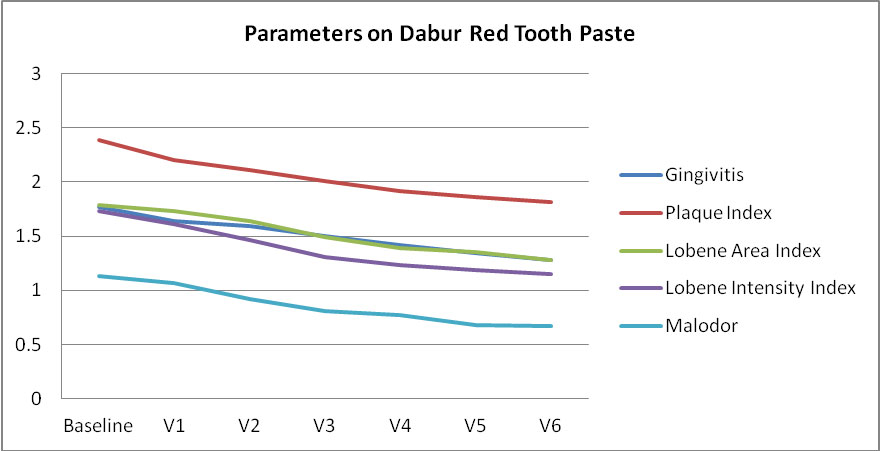1. DABUR RED PASTE - INTRODUCTION
Ayurvedic literature suggests a number of medicinal herbs, which can be used for teeth cleaning as well as massaging of gums. In an effort to determine the efficacy of this herbal paste (Dabur Red Toothpaste), a three month, comparative, randomized, parallel design clinical study was conducted to evaluate the efficacy of the said paste for the control of plaque, gingivitis, staining of tooth and malodor.

2. MATERIALS AND METHODS:
The herbal ingredients of Dabur Red Toothpaste are Garik powder (Red ochre), Pippali (Piper longum), Maricha (Piper nigrum), Sunthi (Zingiber officinale), Tomar beej (Zanthoxylum armatum), Karpoor (Cinnamomum camphora), Laung ka Tail (Oil of Syzygium aromaticum) and Pudina satva (Mentha piperita).
Subjects participating in the clinical study were enrolled from S.P Dental College after considering to inclusion/exclusion criteria and informed consent. The investigational products were used twice daily for approximately 1 minute in morning and before going to bed with Binaca Top soft bristles tooth brush as per the brushing instructions from Baseline Visit for 12 weeks and were called for evaluation after every 2 weeks interval up to 12th week and also for follow Visit as visit 7 on 13th week.
3. OBSERVATIONS & RESULTS:
A total of 550 subjects were screened for recruiting in the study. Out of which, 441 subjects completed the total study duration with 9 subjects as dropouts; however, no investigation product related reasons were reported in any of the dropouts. In Dabur Red Toothpaste group, 83 were Female and 67 were males and the mean age was 29.4 ± 8.44 (n=150).

3.1. Gingivitis:
In Dabur Red Toothpaste, the gingival scores were decreased and was statistically significant from visit 1 onwards. The percentage reduction of gingival score from baseline to visit 6 was 27.82. There was no recurrence of the condition during the follow-up period of one week without investigational product in any of the groups. Moreover, there was a continued effect on reduction of mean gingival index scores from visit 6 to visit 7, even after stoppage of investigational products (10.26%).3.2. Plaque:
In Dabur Red Toothpaste, the mean Plaque Index Scores were decreased which was statistically significant from visit 1 onwards. The percentage reduction of plaque score from baseline to visit 6 was 24.30. There was no recurrence of the condition during the follow-up period of one week without investigational product in any of the groups; moreover, there was a continued effect on reduction of mean Plaque Index scores from visit 6 to visit 7, even after stoppage of investigational products.3.3. Stain:
- 3.3.1. Lobene Area Index Scores
In Dabur Red Toothpaste the Lobene Area Index Scores were decreased which was statistically significant in all the groups from visit 1 onwards. The percentage reduction of score from baseline to visit 6 was 28.89. There was a continued effect on reduction of mean scores from visit 6 to visit 7, even after stoppage of investigational products.- 3.3.2. Lobene Intensity Index:
In Dabur Red Toothpaste, there was a decrease observed in mean Lobene Intensity Index Scores which was statistically significant from visit 1 onwards. The percentage reduction of Lobene Intensity Index score from baseline to visit 6 was 33.53. There was a continued effect on reduction from visit 6 to visit 7, even after stoppage of investigational products.- 3.3.3. Malodor:
There was decrease in mean Organoleptic Scores in Dabur Red Toothpaste group for Malodor scores, which was statistically significant from visit 1 onwards. The percentage reduction of malodor score from baseline to visit 6 was 40.87. There was a continued effect on reduction of mean Organoleptic Scores for Malodor scores from visit 6 to visit 7 was observed, even after stoppage of investigational product (3.42%)| Groups | Baseline | V1 | V2 | V3 | V4 | V5 | V6 |
|---|---|---|---|---|---|---|---|
| Gingivitis | 1.77 | 1.64 | 1.59 | 1.50 | 1.42 | 1.34 | 1.28 |
| Plaque Index | 2.39 | 2.20 | 2.11 | 2.01 | 1.92 | 1.86 | 1.81 |
| Lobene Area Index | 1.79 | 1.73 | 1.64 | 1.49 | 1.39 | 1.35 | 1.28 |
| Lobene Intensity Index | 1.73 | 1.61 | 1.46 | 1.31 | 1.23 | 1.19 | 1.15 |
| Malodor | 1.13 | 1.07 | 0.92 | 0.81 | 0.77 | 0.68 | 0.67 |
4. CONCLUSION
The following may be concluded based on the results of the clinical study on the Dabur Red Toothpaste:- With Dabur Red Toothpaste a statistically significant improvement was observed in all four conditions assessed in the study viz. Plaque, Gingivitis, Stain and Malodor as compared to baseline.
- Dabur Red Toothpaste use has shown a clinically significant persistent effect and no immediate reversal of condition after stoppage of its use in all four conditions viz. Plaque, Gingivitis, Stain and Malodor.
- None of the subjects in Dabur Red Toothpaste group reported any adverse effects throughout the study period. This indicates the clinical safety of the toothpastes used in the study.

*As per Clinical Trial No. DRF/AY/5004/CT-2 carried out by Dabur India Limited
As per Clinical Trial CTRI/2014/11/005212




